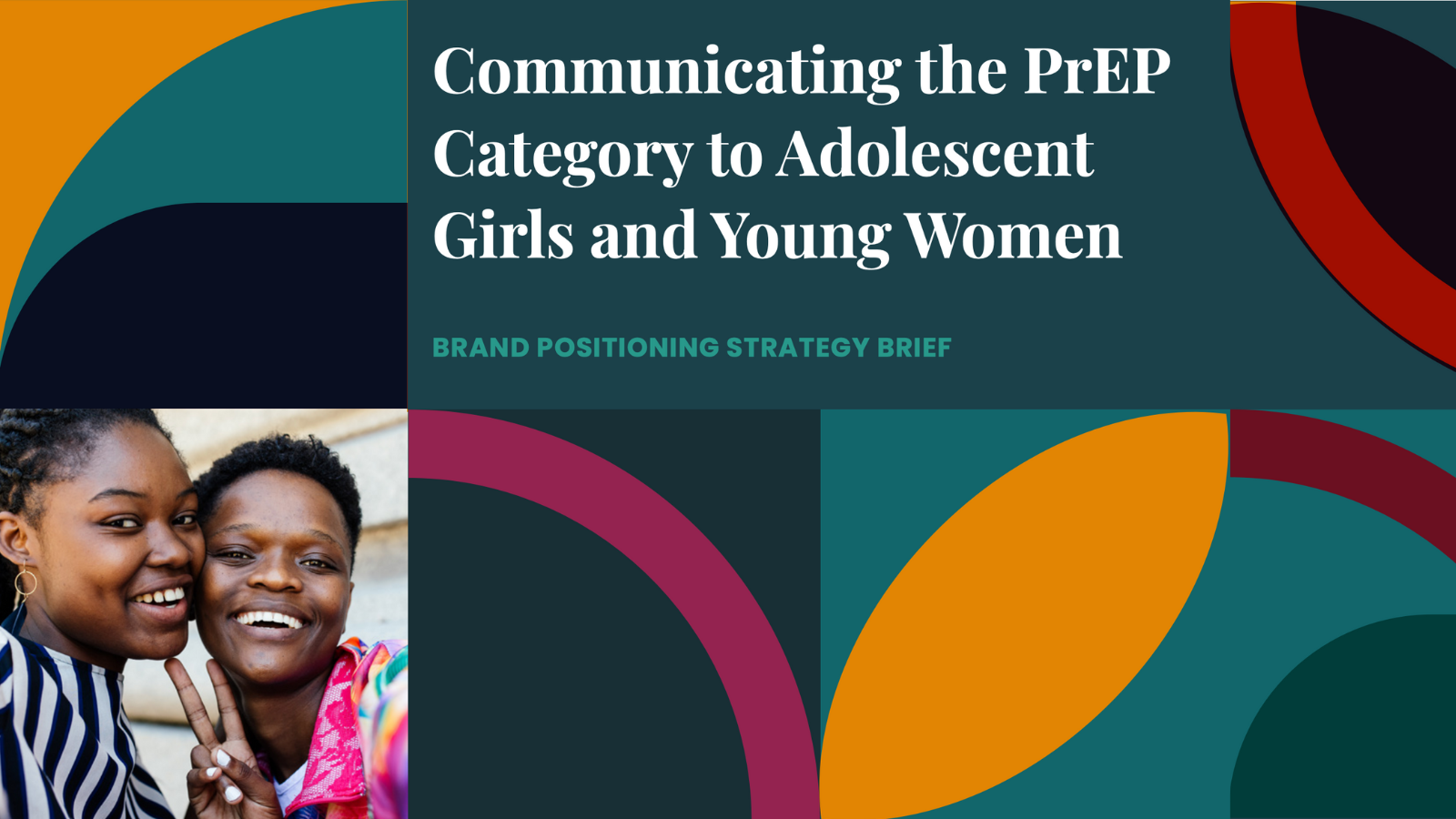Emily Donaldson, FHI 360
Casey Bishopp, FHI 360
As the pre-exposure prophylaxis (PrEP) category expands to include new products, our marketing and demand generation efforts must communicate with young women about PrEP and product choice in their language so they are ultimately inspired to act.
That’s why MOSAIC set out to build a strong, evidence-informed, unified brand for the category. This brand is designed to shape marketing and demand generation efforts so that all communication is aligned under a common strategy built on robust evidence and a deep understanding of young women’s relationship with PrEP.
OUR APPROACH
Our first step in building a brand for the PrEP category was to develop a positioning strategy that answers the question: What do we want young women’s hearts to feel and minds to think about PrEP?
Brand positioning is typically built through an internal process involving a narrow set of stakeholders. For the PrEP category, MOSAIC intentionally worked alongside many internal and external stakeholders to ensure we designed the strongest possible strategy with buy-in toward application across settings.
First, we reviewed all available insights and campaigns focused on adolescent girls, young women, and PrEP. We included near-to-market, nearly at market, or already available products—oral PrEP, PrEP ring, CAB PrEP, and products still in the pipeline, such as the dual-prevention pill—to ensure the strategy is applicable when these products do come to market.
We employed a phased consultative and collaborative process with implementers, ministry of health representatives, and advocates and activists from across MOSAIC countries. MOSAIC’s youth advisors, the NextGen Squad, played a pivotal role in developing the strategy. They ensured audience insights brought into the strategy reflected and were resonant with today’s young women in their countries. The Squad helped us apply a gender-transformative lens, ensuring the insights that form the backbone of this brand positioning strategy support equality and promote the relative position of women, girls, and marginalized groups.
- For a comprehensive overview of our process, which leverages private sector approaches, see here.
WHAT WE LEARNED
To validate the strategy, we held group discussions with 121 young women in Kenya, South Africa, and Zimbabwe. During these sessions, participants evaluated three posters and narratives that represented creative interpretations of the positioning strategy. Data from those groups were collected through review and ratings forms and posters marked up with participants’ feedback, as well as transcript-style notes for each session.
Next, we organized the data and analyzed them for insights.
- See our insights report: a comprehensive look at what we learned through validating the positioning direction. It explains the methodology, outlines country-specific reactions to the positioning direction, and distills key findings that were applied to refine the positioning to honor the experiences and perspectives of young women today.
Insights were then aligned with a marketing framework that considers four inputs—culture, category, consumer, and product—which ladder up to the key brand benefit, or the emotionally engaging focus of the brand.
Four themes emerged through validation:
- PrEP is self-care to young women. To adolescent girls and young women (AGYW), self-care means loving yourself enough to take care of yourself.
- Taking PrEP gives AGYW peace of mind. Using PrEP makes them feel safe and is seen as an essential way to ease the anxiety of momentary perceptions of risk for young women.
- PrEP confirms the strength and power young women already have. It supports AGYW in putting themselves first.
- PrEP choice puts AGYW in control. For the first time, young women can not only control whether to use PrEP, but also which method to use.
These four key themes reveal that to stand out, communication should resonate with young women’s inner strength, their unwavering determination to live a full and healthy life, and their commitment to self-care as an act of self-love. PrEP is a way for young women to prioritize their physical health and mental well-being, to live a life uninterrupted by HIV.

REVEALING OUR FINAL STRATEGY
This intensive and collaborative process ultimately resulted in our strategy brief, Communicating the PrEP Category to Adolescent Girls and Young Women. Drawing on all we learned throughout the positioning process, the brief provides a narrative explanation of how to communicate the PrEP category to AGYW and includes actionable guidance on developing communication that will resonate and inspire action.
The positioning strategy can be applied in three ways. Implementers can use it to: 1) revise existing and create new communication strategies, 2) inform demand generation campaigns, and 3) refresh existing creative materials for a multi-product market.
PrEP category positioning that is applied across demand generation efforts provides the foundation for clear, impactful, positive, and consistent communication that will get the attention of AGYW and make a lasting impression.
Stay tuned! Our brand guidelines based on the positioning strategy will be available in early 2024.
Featured Graphic: 2Stories


